We are keenly aware that employees are our source to creating value for our customers. We are committed to fostering a culture that places employee wellness first, and building a workplace that makes employees happy and satisfied. We aim to heighten our productivity and creativity for sustainable growth by strategically managing and promoting employees' health and welfare at the company management level.
Human capital objectives and measures
Wellness Management
Declaration
Message from the Chief Wellness Officer
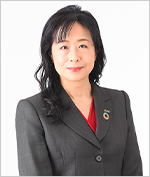
At the SATO Group, we commit to improving employee well-being through various efforts such as holding sports day events for employees and their families. Since making our declaration for wellness management in 2015, the chief wellness officer was established and we formed a committee to create systems for providing health information and investing in employee well-being, with the belief that higher health awareness leads to higher productivity.
General well-being requires fulfilling all three aspects of physical, mental and social health, and what employees expect at work, their values and preferred lifestyles shift with changing times. As CWO, I believe we can do more to help our employees thrive and excel in the workplace.
Together with group companies around the world, we will continue to pursue our three pillars of wellness management in preventing lifestyle diseases, promoting regular exercise and raising employee awareness, while working to create a diverse and engaging workplace in sync with human resource strategies.
Naomi Maze
Executive Officer and CWO
SATO Corporation
Our wellness slogan
“The 3G actions for well-being”
Greet with a smile
Maintain a Good condition (physically and mentally)
Do a Great job (with high productivity)
Recognitions
Recognition for outstanding health and productivity management

Our efforts to engage employees in various wellness activities have won us the Certified Health & Productivity Management Outstanding Organization recognition for nine consecutive years since 2017. Aimed at increasing awareness of employee wellness, this recognition is given to companies that practice outstanding health-conscious management in collaboration with their health insurance societies.
Our medium-term goals (through FY 2030)
Challenges wellness management can tackle, and our strategy map
Since making the declaration in 2015, we have been building structures/systems for promoting wellness, while drafting and executing wellness promotion plans. The strategy map below illustrates how wellness management can solve the company's challenges and ultimately help us fulfill our declaration.
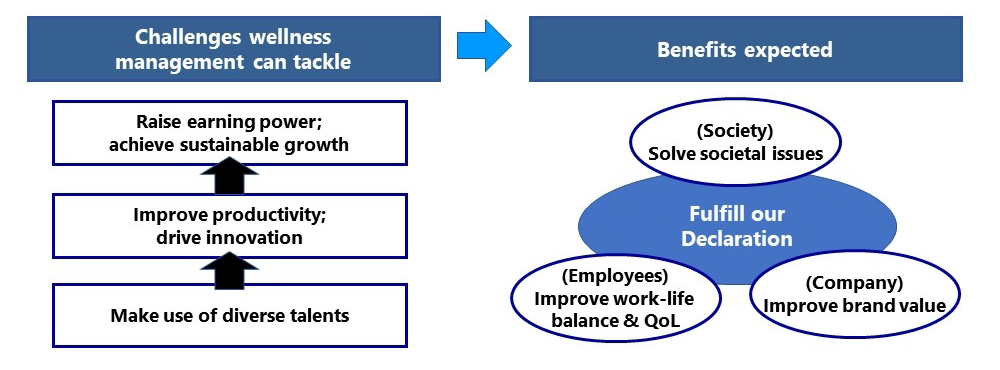
 Strategy map
Strategy map
Our medium-term goals (through FY 2030)
In helping employees enrich their work and personal lives, we have set key wellness indicators to track over the medium term and are offering health initiatives for everyone.
We also combat presenteeism, focusing on preventing lifestyle diseases, promoting regular exercise and raising health awareness in employees. With the pandemic impacting exercise habits, fewer employees were physically active for the past few years while the ratio of employees with metabolic syndrome remained flat year on year. In view of these results, we organized walking events among other initiatives in and outside Japan to help employees stay fit. As the time-based smoking bans and cessation measures by rank we had implemented to reduce smoking ratio no longer improve the situation any further, we have started additional measures, including one aimed at curbing passive smoking.
| Metrics we monitor | FY 2019 results | FY 2020 results | FY 2021 results | FY 2022 results | FY 2023 results | FY 2024 results | FY 2030 targets |
|---|---|---|---|---|---|---|---|
| 1. Employees with metabolic syndrome*1 | 17% | 18% | 17% | 16% | 18% | 17% | 10% |
| 2. Employees who exercise regularly*2 | 39% | 38% | 35% | 33% | 36% | 24% | 50% |
| 3. Walking campaign participation rate | 12% | 20% | 16% | Japan: 16% | 20% | Japan: 26% | - |
| Global: 23% | Global: 9% | ||||||
| 4. Holding of global, online wellness event | - | - | Yes | - | Yes | - | - |
| 5. Employee smoking ratio | 24% | 22% | 20% | 18% | 20% | 20% | 10% |
| 6. Employees receiving specific health guidance (to prevent lifestyle diseases)*1 | - | - | 10% | 13% | 24% | 39% | 50% |
| 7. Employees with healthy weight*1 | - | - | - | - | 61% | 62% | 65% |
1 Based on corresponding health screening data of employees aged 40 or above
2 Minimum 30 minutes of exercise at least twice a week or walking an average 8,000 steps per day, over the span of at least one year
Key initiatives
Health screening for all
At the SATO Group, we offer employees regular health checkups that are more thorough than the legal requirement. For employees above the age of 38, we mandate comprehensive medical examinations to enable more detailed screening. Our occupational health physician looks at the checkup results of all employees and provides health coaching as necessary.
| FY 2018 | FY 2019 | FY 2020 | FY 2021 | FY 2022 | FY 2023 | FY 2024 | |
|---|---|---|---|---|---|---|---|
| Percentage of employees receiving regular health screening | 100% | 99.20% | 99.60% | 100% | 100% | 100% | 100% |
Follow-up call from the CWO
For employees who do not go back for a follow-up examination or treatment when their screening results so require, our occupational health physician / nurse will give them reminders. For those that still do not comply, the CWO will personally call to prevent them from neglecting red flags that may develop into serious diseases.
Health consultation for lifestyle diseases
For employees who are at high risk for lifestyle diseases and can expect significant reduction of their individual risk factors by making better lifestyle choices, we get a registered dietitian from outside the company to assist them in making healthy dietary and lifestyle changes.
Interventions relating to mental health
At SATO, we regularly check our employees' stress levels and analyze the results to discover problems early to address them and improve the workplace environment. Also, we make it possible for employees to easily access the company's occupational health physician/nurse or counselor for face-to-face consultation or counseling as necessary.
| FY 2018 | FY 2019 | FY 2020 | FY 2021 | FY 2022 | FY 2023 | FY 2024 | |
|---|---|---|---|---|---|---|---|
| Percentage of employees undertaking stress risk assessment | 97% | 92% | 90% | 90% | 88.90% | 93.40% | 93.80% |
Deepening employees' understanding of health issues
Besides optional correspondence courses, we also use the services of Cradle, an employee benefits provider for supporting women's health, to provide online seminars in Japan starting FY 2023 on different topics such as exercise, sleep, diet, drinking, mental well-being, workplace harassment, coping with illness, diversity, hay fever and gender-specific health care.
| FY 2023 actual | FY 2024 actual | FY 2026 target | |
|---|---|---|---|
| Percentage of employees using Cradle | 16% | 25% | 50% |
Health and work performance questionnaire
In FY 2024, we started assessing presenteeism and absenteeism through questionnaires.
| FY 2024 results | |
|---|---|
| Percentage of employees with low presenteeism*1 | 82% |
| Percentage of employees with no absenteeism*2 | 66% |
1 Employees who performed at 80 to 100 percent in the past month, according to their responses to the single-item presenteeism question developed by "The University of Tokyo Working Group"
2 Employees who did not take any time off work due to health issues in the past three months, according to their questionnaire responses
Promoting work–life balance
Reduce excessive work hours
We encourage employees to reduce overtime without losing productivity, through initiatives like the once-a-week Work Smart Day that is introduced in Japan.
| FY 2019 | FY 2020 | FY 2021 | FY 2022 | FY 2023 | FY 2024 | |
|---|---|---|---|---|---|---|
| Average monthly overtime hours | 17 | 17 | 17 | 18 | 18 | 17 |
Improve utilization of annual paid leave
We encourage employees to use paid leave days, through flexible workstyles and other employee-friendly arrangements.
| FY 2019 | FY 2020 | FY 2021 | FY 2022 | FY 2023 | FY 2024 | |
|---|---|---|---|---|---|---|
| Annual leave utilization rate* | 60% | 52.8% | 59.5% | 64.7% | 69.4% | 68.2% |
Data excludes employees who are on long-term leave (for more than a month), or who join or leave the company in the middle of the year
Encouraging smoke-free lifestyles
SATO sets "10 percent smoking ratio by 2030" as a key performance indicator for its wellness management. We are promoting a new round of smoking cessation measures to help improve the health of both smoking and non-smoking employees and their family members.
Message from the Group CEO on smoking cessation measures
At SATO we rejoice in change, starting winds of change ourselves and adapting to new environments. This is true in our approach to wellness management as well.
For example, we began providing non-smoker allowances in 1998 before smoking cessation measures at workplaces became commonplace in Japan. Until 2015, they have helped employees make better health choices.
As we look ahead to envision how we want to be when the company is 100 years old, we want to make fresh efforts to encourage employees to pay more attention to their mental and physical well-being as a foundation for everything they do and inspire behavioral changes, so that they can continue to keep innovating in their work.
As part of these efforts, we will take additional steps toward achieving an employee smoking rate of less than 10 percent by 2030. The measures would offer smokers the opportunity to quit smoking voluntarily while protecting non-smokers from passive smoking.
We commit to helping our employees and their families boost their health to live fulfilling lives.
Hiroyuki Konuma
President and Group CEO
SATO Corporation
Repurpose all existing smoking rooms/areas (Oct 2023 to Mar 2025)
After communicating with branch offices nationwide, we have removed all existing smoking rooms/areas in phases and converted them into additional office spaces, break rooms or storages.
Offer a new stipend (from Jun 2024)
For employees who submit personal health goals to the company, we used to provide a monthly stipend to help pay for their gym membership, smoking cessation treatment or other fitness/wellness-related expenses. From FY 2024, this is replaced by a new non-smoker allowance for non-smokers and anyone who successfully quits smoking. We will continue to support employees who wish to quit smoking through support programs such as the online counselling offered by our health insurance society.
Fully ban smoking (from Apr 2025)
From FY 2025, we introduced a smoking ban during work hours on all company premises in Japan. We also made a video to help employees understand why the company is promoting smoking cessation measures as part of wellness management so that they can explain the smoking ban in the right context to their peers, juniors or business partners.
Events to promote exercise as a way of life
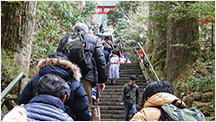
Every year, we participate in the national walking event organized by our health insurance society.

First held in 1966, the SATO Sports Day has become an annual event for employees and their family members to communicate and interact with one another, while engaging in physical activities for good health and fitness.
Global health promotion events
Online wellness event
In December 2021, we held an online event for all SATO Group employees, with the aim of addressing a general lack of physical activity as many were working from home throughout the COVID-19 pandemic. Employees created fun and energetic videos within three categories — dance, push-ups and a hand labeler race* — which resulted in 123 submissions in total. Over 1,400 employees gathered online for the event closing, where the most popular videos in each category as voted in-house were awarded. In February 2024, we held the event again and received 219 submissions this time.
Also, we organized a global walking campaign dubbed Walk as ONE in 2022 and 2024 to create opportunities for employees to exercise. In the first year, more than 1,300 employees participated, collectively walking a distance equivalent to circling the earth 4.7 times. In the second year, 895 employees took part, achieving a total distance equal to 3.3 laps around the globe.


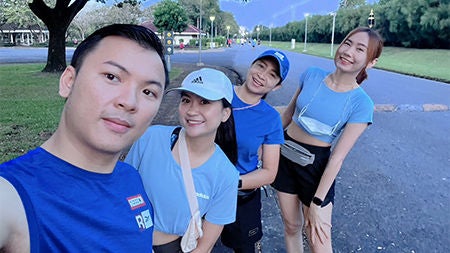
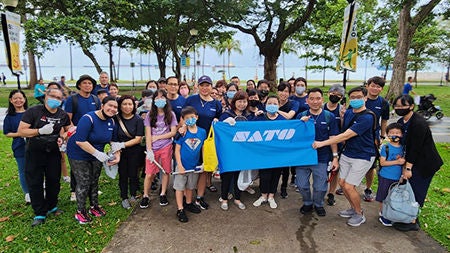
Contestants took part in a race using our hand labeler — normally used for affixing price tags — to see who could label a certain number the fastest. The hand labeler is a long-selling product that has been used by many companies, mainly retailers, since its invention by our founder, Yo Sato, in 1962.
Calisthenics video to help employees stay fit
To help employees stay physically active, we encourage everyone working remotely or in the office to do a simple stretching routine at the start of their day or before meetings by following a pre-recorded calisthenics video featuring our CWO and department managers.
 Stretching before meetings
Stretching before meetings
Employee-led wellness activities
Wellness leaders of each company and department play the central role in planning and leading activities designed to help manage and improve employee wellness at their respective companies/offices/departments.
 Sales members at one of their regular table tennis events
Sales members at one of their regular table tennis events
 R&D members trying out indoor bouldering
R&D members trying out indoor bouldering
 Internal community site to share wellness management activities
Internal community site to share wellness management activities
 Our quarterly in-house magazine distributed around the world regularly reports on wellness stories
Our quarterly in-house magazine distributed around the world regularly reports on wellness stories
In-house awards for wellness promotion
Wellness Management Promotion Award
We annually recognize and award the office or department that ran the most notable wellness activity, or the activity leader who made a significant contribution to the company's drive for wellness. Selection is based on ten criteria that include planning, quality, originality, frequency, participation rate, and level of involvement in online community.
Our workplace health promotion team
Our CWO and Wellness Promotion Committee work together with 230 internal wellness promotion leaders who are selected from the management and staff of different group companies/offices/departments. Plans, as well as achievements, are reported to the board of directors and Senior Executive Management Meeting as and when necessary.

Memberships
A member of the KENKO Kigyokai
We have been a member of the KENKO Kigyokai (corporate wellness association) since 2016 as we share its ideals for companies to play a part in increasing health expectancy in Japan through wellness management. So far, we have participated in workgroup activities for smoking cessation, mental health and healthy diet and exercise to deepen our understanding of these topics.
